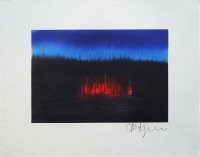
Details
Artist
Styles
Edition of 80 - Transparency printed in colours flush-mounted to glass in an aluminium electrical light box - In excellent condition. // Svayambh by Anish Kapoor, created in 2007, is a limited edition mixed-media print that merges industrial and organic forms in a striking visual statement. This artwork features a large, slab-like structure smeared with a thick, reddish-brown substance, evoking a sense of both movement and stagnation. The piece is presented as a transparency printed in color, flush-mounted to glass within an aluminum lightbox, which illuminates the textures and earthy tones of the material. Kapoor’s work often explores themes of transformation and the interplay between mass and void, and Svayambh (“self-generated” in Sanskrit) may symbolize a cycle of creation and destruction. The industrial setting and visceral texture invite viewers to ponder the dynamic nature of matter, encouraging a tactile, almost visceral response to the materiality of the artwork.
Svayambh, 2007
form
Medium
Size
45.8 x 60.5 X 2.5 cm
- Inches
- Centimeters
Edition
Price
Details
Artist
Styles
Edition of 80 - Transparency printed in colours flush-mounted to glass in an aluminium electrical light box - In excellent condition. // Svayambh by Anish Kapoor, created in 2007, is a limited edition mixed-media print that merges industrial and organic forms in a striking visual statement. This artwork features a large, slab-like structure smeared with a thick, reddish-brown substance, evoking a sense of both movement and stagnation. The piece is presented as a transparency printed in color, flush-mounted to glass within an aluminum lightbox, which illuminates the textures and earthy tones of the material. Kapoor’s work often explores themes of transformation and the interplay between mass and void, and Svayambh (“self-generated” in Sanskrit) may symbolize a cycle of creation and destruction. The industrial setting and visceral texture invite viewers to ponder the dynamic nature of matter, encouraging a tactile, almost visceral response to the materiality of the artwork.
- Recently Added
- Price (low-high )
- Price (high-low )
- Year (low-high )
- Year (high-low )
What is new British Sculpture?
New British Sculpture is the name referring to the work produced by a group of sculptors, installation artists, and other creators who exhibited together in London during the 1980s. This group included artists like Richard Deacon, Richard Wentworth, and Tony Cragg. Tim Woods helped define this movement by identifying four major themes: the blending of kitsch and pop culture, the use of UK urban waste in a bricolage style, the assignment of new meanings to everyday objects, and a playful approach using wit and humor.





















